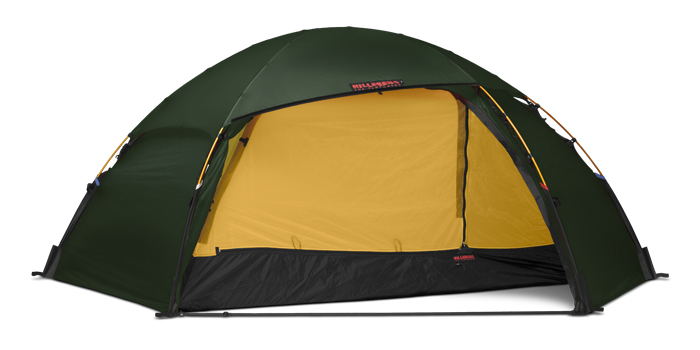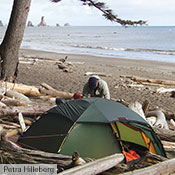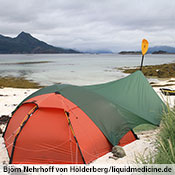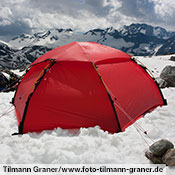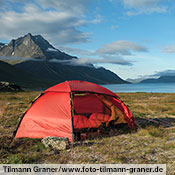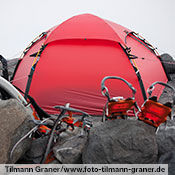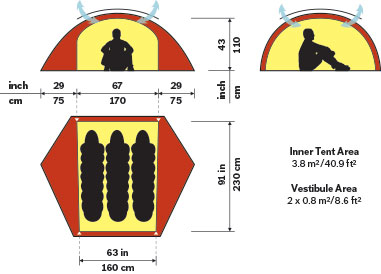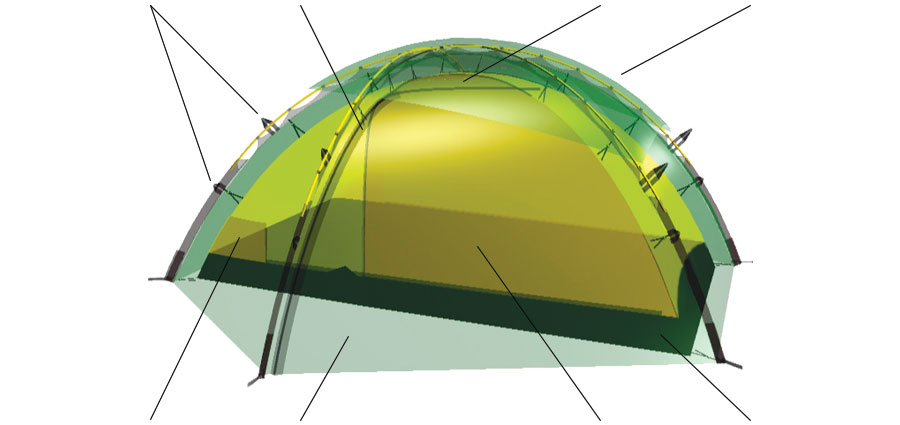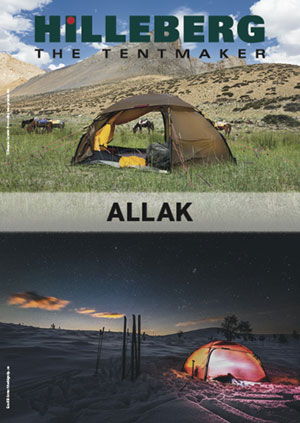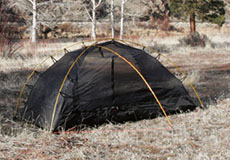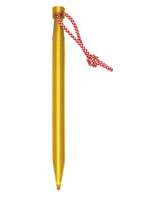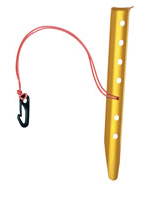We introduced our Red Label Allak in 2008, and it quickly became – and has remained – one of our most popular tents. But that popularity is directly related to its proven design, which we created with our first fully free standing tent, the Black Label Staika.
Introduced in 1990, the two person Staika was originally conceived for paddle tourers in Sweden, who were asking for a free standing tent so they could more easily camp on the flat, rocky spits and islands so common in Sweden’s Archipelagoes. “We wanted to build a fully free standing tent,” recalls Bo Hilleberg. “Most dome tents are really self-supporting rather than free standing, since they still need to have their vestibules pegged.” To create what became the Staika, Bo constructed a true dome shape with three poles, and built two entrances and two vestibules into that structure, so no pegs would be needed to make the vestibules be functional.
While the Staika was an immediate success with the paddlers, it quickly became a favorite of other users, as well. “We made a few prototypes in 1989 and sent them to a German scientific group doing an expedition to the South Pole,” says Bo. “They found it ideal, since it could be pitched anywhere and it was very, very strong.” Indeed, because of its simple dome shape, the Staika was both remarkably roomy and exceptionally strong in very windy, snowy conditions. Its two entrance/two vestibule format provided plenty of storage as well as flexible entry and exit options in poor weather. Add that to its adaptability in tough pitching conditions, and mountaineers quickly found it perfect for their needs, as did ski mountaineers and long distance motorcycle tourers.
Fast forward to 2006, when we began development on what became the Allak. We had had great success in building the Nallo and Nallo GT, Red Label “versions” of the Nammatj models, and we had just introduced the Kaitum, a Red Label “version” of the Keron. We knew there was great demand for lighter all season tents, so it seemed natural to use the Staika as the inspiration for a two person, fully free standing Red Label tent.
In 2003, we had replaced the Staika’s full pole sleeves to our short pole sleeve and clip system, and we used that same system on the Allak. Since Red Label tents prioritize lighter weight over absolute comfort and strength, we used the same 9 mm poles and Kerlon 1200 outer tent fabric found in other Red Label models. To keep the weight even lower, we also sized the Allak a bit smaller than the Staika and tweaked the design. To accommodate the new tent’s lower profile, we reconfigured the vent system, building in separate vents above each entrance, where in the Staika the vents are integrated into the door zippers. We also increased the size of the vent cover, and added a rain gutter to prevent drippage while entering and exiting. We also discovered that the new design lent itself to a smaller version, as well, so we created our one-person Soulo to complement the two-person Allak.
Upon its release in 2008, the Allak was an immediate success. “At first,” says Bo, “the Allak was popular with those who spent time in the Swedish Archipelago. But we knew from the beginning that other users would like it very much.” And so it has proved. While not quite as strong as its “big brother,” the Staika, the Allak has become one of our best “all around” tents, working as well for backpackers, hunters and mountaineers as it does for paddlers. “During development,” says Bo, “all of us at the office would take the Allak, since it was able to be used anywhere: in the forest, above the tree line, anywhere. And it is very light and comfortable!”
We introduced our Red Label Allak in 2008, and it quickly became – and has remained – one of our most popular tents. But that popularity is directly related to its proven design, which we created with our first fully free standing tent, the Black Label Staika.
Introduced in 1990, the two person Staika was originally conceived for paddle tourers in Sweden, who were asking for a free standing tent so they could more easily camp on the flat, rocky spits and islands so common in Sweden’s Archipelagoes. “We wanted to build a fully free standing tent,” recalls Bo Hilleberg. “Most dome tents are really self-supporting rather than free standing, since they still need to have their vestibules pegged.” To create what became the Staika, Bo constructed a true dome shape with three poles, and built two entrances and two vestibules into that structure, so no pegs would be needed to make the vestibules be functional.
While the Staika was an immediate success with the paddlers, it quickly became a favorite of other users, as well. “We made a few prototypes in 1989 and sent them to a German scientific group doing an expedition to the South Pole,” says Bo. “They found it ideal, since it could be pitched anywhere and it was very, very strong.” Indeed, because of its simple dome shape, the Staika was both remarkably roomy and exceptionally strong in very windy, snowy conditions. Its two entrance/two vestibule format provided plenty of storage as well as flexible entry and exit options in poor weather. Add that to its adaptability in tough pitching conditions, and mountaineers quickly found it perfect for their needs, as did ski mountaineers and long distance motorcycle tourers.
Fast forward to 2006, when we began development on what became the Allak. We had had great success in building the Nallo and Nallo GT, Red Label “versions” of the Nammatj models, and we had just introduced the Kaitum, a Red Label “version” of the Keron. We knew there was great demand for lighter all season tents, so it seemed natural to use the Staika as the inspiration for a two person, fully free standing Red Label tent.
In 2003, we had replaced the Staika’s full pole sleeves to our short pole sleeve and clip system, and we used that same system on the Allak. Since Red Label tents prioritize lighter weight over absolute comfort and strength, we used the same 9 mm poles and Kerlon 1200 outer tent fabric found in other Red Label models. To keep the weight even lower, we also sized the Allak a bit smaller than the Staika and tweaked the design. To accommodate the new tent’s lower profile, we reconfigured the vent system, building in separate vents above each entrance, where in the Staika the vents are integrated into the door zippers. We also increased the size of the vent cover, and added a rain gutter to prevent drippage while entering and exiting. We also discovered that the new design lent itself to a smaller version, as well, so we created our one-person Soulo to complement the two-person Allak.
Upon its release in 2008, the Allak was an immediate success. “At first,” says Bo, “the Allak was popular with those who spent time in the Swedish Archipelago. But we knew from the beginning that other users would like it very much.” And so it has proved. While not quite as strong as its “big brother,” the Staika, the Allak has become one of our best “all around” tents, working as well for backpackers, hunters and mountaineers as it does for paddlers. “During development,” says Bo, “all of us at the office would take the Allak, since it was able to be used anywhere: in the forest, above the tree line, anywhere. And it is very light and comfortable!”
Allak user
Tilmann Graner
Tilmann Graner has had a life-long love affair with the outdoors. A native of Germany, he grew up playing in the mountains, climbing rock and ice, skiing, and hiking. “Mountain climbing is my passion,” he says. “both classic mountaineering and ski mountaineering. And I like solitude, so I like to sleep in a tent!” Day to day, he lives in Sondershausen, Germany, and is a bassoonist for Loh-Orchester Sondershausen/Theater Nordhausen. “The orchestra is closed for 6 weeks in July and August,” he says, “so we travel then.” He and his partner of over 20 years, Susanne Jacoby (also a bassoonist), do one big vacation in the summer, and a shorter one in late winter. “And, of course, many small trips closer to home.” On their longer adventures, the two have trekked and/or climbed in Iceland, Yosemite, USA, Turkey and India, twice in Nepal, multiple times in Bolivia, Peru and Canada, and three times in Greenland. Shorter trips take them climbing and trekking in the Alps and Norway, among other places. Their most recent long trip was in Canada. “We were trying to reach Mt. Waddington,” he says. “We were out 16 days and didn’t see anyone and almost no signs of any humans, other than one cairn and part of a lost sleeping mat.” For most of their trips, they use their Allak, which he calls “the perfect trekking tent. It’s got excellent ventilation, it’s roomy, and it’s strong enough for nearly anything. On a three week trekking trip, it’s important to have a strong tent!” In addition to his work as a musician, Tilmann is also a professional photographer, specializing in portrait and commercial work, and stage photography, with an emphasis on dance productions (although many images he has taken on his trips have been in Hilleberg catalogs for over 10 years, including the cover shot in 2015). And he currently has an exhibition of his landscape work, “Out of the White – On the Beach,” in a regional gallery. “I like to create images that let people see – or have to guess – the size of the landscape,” he says. (For more information, see foto-tilmann-graner.de)

 Cart
Cart






